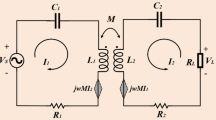Abstract
The use of various technologies to increase efficiency and safety has been continuously increasing. Wireless power transfer (WPT) has emerged as a key technology to increase in this regard. WPT can simplify complex wiring and improve safety by eliminating the need for mechanical contact. Most electronic devices used in buildings are of medium power, and research is being conducted to increase the output power of WPT through the combination of different technologies. This study proposes a 4-Tx WPT system using four transmitters (Tx) to satisfy the power requirements of medium-power electronic devices used in buildings. The existing WPT methods, 1-Tx and 2-Tx, were compared with the proposed 4-Tx WPT. The characteristics of efficiency and output power were analyzed through each Tx phase control of the 4-Tx system. The mutual inductance based on the distance between Tx and Rx was measured, and the relationship between the efficiency and output power was analyzed. Experimental results show that the proposed 4-Tx system is more advantageous in terms of medium power than the existing WPT methods. The proposed WPT system has power control capability, high output power, and high efficiency by adapting the phase control of each Tx. Moreover, it is confirmed that the range of the distance between Tx and Rx that is satisfying the minimum output power of medimum-power electronic device based on the relationship between the efficiency and the output power with the separation distance of Tx and Rx.

































Similar content being viewed by others
References
M. Nuotio, M. Ilic, Y. Liu, J. Bonanno and P. J. Verlinden: Innovative AC photovoltaic module system using series connection and universal low-voltage micro inverters. 2014 IEEE 40th Photovoltaic Specialist Conference. 1367–1369 (2014). doi: https://doi.org/10.1109/PVSC.2014.6925172
A. M. Sadati, S. Krauter and J. Bendfeld: Comparison of micro inverters based on practical analysis. 2015 5th International Youth Conference on Energy. 1–6 (2015). doi: https://doi.org/10.1109/IYCE.2015.7180817
Loba, T.H., Salim, K.M.: Design and implementation of a micro-inverter for single PV panel based solar home system. Int. Conf. Inform. Electron. Vision. (2013). https://doi.org/10.1109/ICIEV.2013.6572661
Dursun, M., Görgün, A.: A micro inverter design for micro grids. Int. Conf. Electr. Electron. Eng. (2020). https://doi.org/10.1109/ICEEE49618.2020.9102519
Liu, J., Zhao, Z., Ji, J., Hu, M.: Research and application of wireless sensor network technology in power transmission and distribution system. Intell. Converg. Netw. 1(2), 199–220 (2020). https://doi.org/10.23919/ICN.2020.0016
Popovic, Z., Falkenstein, E., Zane, R.: Low-power density wireless powering for battery-less sensors. IEEE Radio Wirel. Symp. 2013, 31–33 (2013). https://doi.org/10.1109/RWS.2013.6486631
So, P.H.; You, H.W.; An, J.S.; Lee, B.H.; Yi, K.H: Characteristics of Wireless Power Transfer System According to The Shape of Magnetic Path. 8th International Conference on Renewable Energy Research and Applications, Brasov, ROMANIA, Nov. 3–6. 280–282 (2019)
Shoki, H.: Trends, technical and regulatory issues, and standardization concerning commercialization of wireless power transfer technologies. Asia-Pac. Microw. Conf. 2014, 1095–1097 (2014)
A. Tak and T. S. Ustun: Wireless power grid: Leapfrogging in power infrastructure of developing countries. 2016 IEEE Region 10 Conference. 1274–1277(2016). doi: https://doi.org/10.1109/TENCON.2016.7848217
G. B. A. Kumar, Shivashankar, N. Sujay, P. Tejas, P. Srikanth and Y. T R: Design and Implementation of Wireless Sensor Network based Smart DC Grid for Smart Cities. 2019 4th International Conference on Recent Trends on Electronics, Information, Communication & Technology. 1453–1458 (2019). doi: https://doi.org/10.1109/RTEICT46194.2019.9016798
A. Pusti, P. K. Das, A. K. Panda, J. Padhi and D. P. Kar: Essential Analysis of MRC-WPT System for Electric Vehicle Charging Using Coupled Mode Theory. 2021 1st Odisha International Conference on Electrical Power Engineering, Communication and Computing Technology. 1–5 (2021). doi: https://doi.org/10.1109/ODICON50556.2021.9429020
Shi, L., Rasool, N., Zhu, H., Huang, K., Yang, Y.: Design and Experiment of a Reconfigurable Magnetic Resonance Coupling Wireless Power Transmission System. IEEE Microw. Wirel. Compon. Lett. 30(7), 705–708 (2020). https://doi.org/10.1109/LMWC.2020.2997068
Dang, Z., Cao, Y., Abu Qahouq, J.A.: Reconfigurable magnetic resonance-coupled wireless power transfer system. IEEE Trans. Power Electron. 30(11), 6057–6069 (2015). https://doi.org/10.1109/TPEL.2015.2422776
Lang, H., Sarris, C.D.: Semidefinite relaxation-based optimization of multiple-input wireless power transfer systems. IEEE Trans. Microw. Theory Tech. 65(11), 4294–4306 (2017). https://doi.org/10.1109/TMTT.2017.2696948
Chen, F., Young, P.C., Garnier, H., Deng, Q., Kazimierczuk, M.K.: Data-driven modeling of wireless power transfer systems with multiple transmitters. IEEE Trans. Power Electron. 35(11), 11363–11379 (2020). https://doi.org/10.1109/TPEL.2020.2989155
Suzuki, A., Hamano, K., Nishikawa, K., Kawasaki, S.: WPT area expansion technique utilizing magnetic MISO beamformer. Asia Pac. Microw. Conf. 2018, 46–48 (2018). https://doi.org/10.23919/APMC.2018.8617250
Huh, S., et al.: Optimal transmitter selection method for maximum power efficiency for wireless power transfer system using multi-transmitter. IEEE Wirel. Power Transf. Conf. (WPTC) 2020, 296–299 (2020). https://doi.org/10.1109/WPTC48563.2020.9295551
Jayathurathnage, P., Liu, F.: Optimal excitation of multi-transmitter wireless power transfer system without receiver sensors. IEEE PELS Workshop on Emerg. Technol. Wirel. nPower Transf. 2019, 25–28 (2019). https://doi.org/10.1109/WoW45936.2019.9030611
Kim, D.H., Ahn, D.J.: Maximum efficiency point tracking for multiple-transmitter wireless power transfer. IEEE Trans. Power Electron. 35(11), 11391–11400 (2020)
Lee, K.S., Cho, D.H.: Diversity analysis of multiple transmitters in wireless power transfer system. IEEE Trans. Power Electron. 49(6), 2946–2952 (2013)
Zhang, J., Cheng, C., Chen, K., Wang, F., Gao, Y.: Analysis of multiple-TX WPT systems using KVL and RX-side RLT. IET Microw. Antennas Propag. 13(12), 1997–2004 (2019)
Johari, R., Krogmeier, V., David, J.: Analysis and practical considerations in implementing multiple transmitters and receivers for wireless power transfer via coupled magnetic resonance. IEEE Trans. Power Electron. 61(4), 1774–1783 (2014)
Jo, H., Kim, J., Seo, S., Bien, F.: A wireless power transfer system with uniformly high transfer efficiency for free arrangement of the receiver in a wide area. IEEE PELS Workshop Emerg. Technol. Wirel. Power Transf. (WoW) 2020, 312–315 (2020). https://doi.org/10.1109/WoW47795.2020.9291258
Lin, D., Zhang, C., Hui, S.Y.R.: Power and efficiency of 2-D omni-directional wireless power transfer systems. IEEE Energy Convers. Congres. Expos. 2015, 4951–4958 (2015). https://doi.org/10.1109/ECCE.2015.7310358
https://www.lkmakita.co.kr/product/goods_view.html?sid=408&depth1=0700&depth2=0701
https://www.samsung.com/sec/tvs/KQ43QA60AFXKR/KQ43QA60AFXKR/
Acknowledgements
This research was supported by the research fund of Hanbat National University in 2020.
Author information
Authors and Affiliations
Corresponding author
Rights and permissions
Springer Nature or its licensor holds exclusive rights to this article under a publishing agreement with the author(s) or other rightsholder(s); author self-archiving of the accepted manuscript version of this article is solely governed by the terms of such publishing agreement and applicable law.
About this article
Cite this article
An, JS., So, PH. & Lee, BH. Characterization of wireless power transfer system with aligned 4-transmitters and 1-receiver. J. Power Electron. 22, 1978–1989 (2022). https://doi.org/10.1007/s43236-022-00515-w
Received:
Revised:
Accepted:
Published:
Issue Date:
DOI: https://doi.org/10.1007/s43236-022-00515-w




